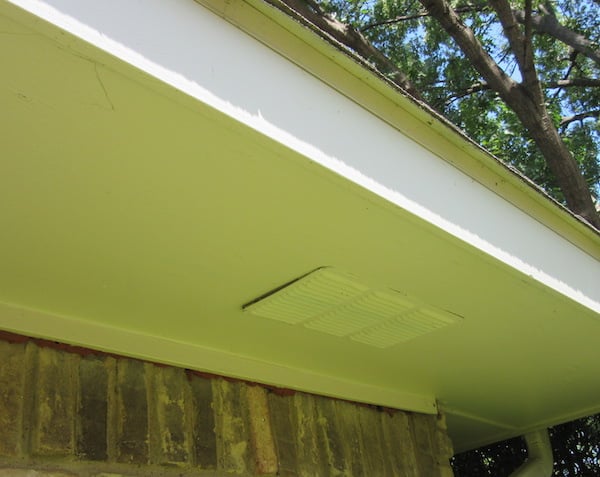
Attic ventilation is important to your home for a number of reasons. For starters, it makes for a cooler attic in the summer time, keeping your home cooler and in turn cutting your air conditioning costs. In the winter attic ventilation drastically reduces moisture and heat buildup in the attic, which can lead to water condensation under your roof and subsequent wood rot, mold and mildew buildup, and failure of your roofing material. In short, proper attic ventilation is a must, and good ventilation starts with a properly installed soffit vent.
What Is a Soffit Vent?
A soffit vent is simply a vent installed into the underside of your home’s eaves (called the soffit) that permits fresh outside air to be drawn up into the attic. Almost all homes are fitted with some kind of roof vents at the peak of the roofline, be it individual roof vents, hip roof ventilation, and many homes have gable vents as well. These provide some ventilation, but when used in conjunction with a soffit vent, they work much more efficiently. Cooler fresh air is drawn up through the soffit at the base of your roof and hot and humid air is expelled through the roof vents at the top.
Continuous or Individual?
There are two main types of these vents available on the market today. The first are called continuous soffit vents. They come in long, narrow vents that run the full length of your soffit. These are best suited for narrow eaves, but can be used on any home. Individual vents are more common, and are cut to fit in between your soffit joists. Their popularity no doubt stems from the fact that they are much easier for a person to install without needing extra help.
How Do I Know If My Home Needs Soffit Ventilation?
Most newer homes should have it installed as a matter of course. Older homes, on the other hand are often without, and there are some years in between where they weren’t installed in sufficient numbers to do much good. Stroll around your house and look under your eves. If you see regularly placed vents under your eaves (individual vents look a lot like furnace registers, continuous venting will look like a thin, narrow aluminum strip running the length of the soffit), you’re good to go. If you don’t see any vents, you need to install some. And if you just see one or two scattered about, you should seriously consider bringing your home up to par.
Can I Do It Myself?
This is certainly a home improvement that an experienced DIY with the right tools can tackle. As mentioned before, installing the individual vents is much easier, especially if you’re working alone, so go that route whenever possible. If you want, or need, to install continuous vents instead, then you’ll probably want to recruit a buddy for the weekend to help out. The process isn’t without challenges, however, and if you don’t already have a garage full of the right power tools, you might save money in the end by hiring the job out to a building contractor. For a professional this is a relatively easy fix, and is likely to take them a day or two at most to get done.
If you’re lacking good attic ventilation, installing a soffit vent where needed is a no brainer. Talk to your local home improvement store, or a professional contractor, and get to improving your attic ventilation as soon as possible. This is one home improvement task that is well worth undertaking.
 Attic Fans Cool the Entire Home
Attic Fans Cool the Entire Home  Air Conditioner Condenser Coil Costs, Repairs & Replacements
Air Conditioner Condenser Coil Costs, Repairs & Replacements  Roof Insulation Captures Escaping Energy
Roof Insulation Captures Escaping Energy  Are Dormers Right for Your Home? A Look at the Pros and Cons
Are Dormers Right for Your Home? A Look at the Pros and Cons  Consider Wood-Burning Furnaces
Consider Wood-Burning Furnaces 

Are You Familiar With This Topic? Share Your Experience.